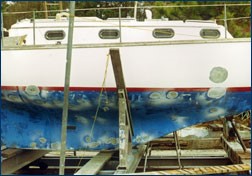Lightning Effects on a Well-Pump: A Case Study
By KR Davis on behalf of Haag Engineering

As an electrical engineer for more than 30 years, I was asked to contact a homeowner who claimed her water looked and tasted bad following a spring storm and alleged lightning strike. The homeowner claimed that her sprinkler system and well pump controller had been damaged. The plumbing to a small prep sink in the breakfast bar had a broken water pipe on the hot water side only. A Yamaha amplifier in the theater no longer worked properly, a surge protector in the office had burned out, and a few other small devices were now useless because of the lightning strike. The biggest issue was, however, that now the “water looks and tastes bad too.”
When I arrived on scene I quickly confirmed the lightning strike. Clear sap was pooling around fresh scars which spiraled around a tall pine tree near the house. Bark was missing where it had exploded off the tree as moisture instantly was turned into steam by the lightning.
Since the storm, the well controller had been replaced and running water was restored. The pump at the bottom of the well was functioning and seemed undamaged by the lightning strike. However, homeowner turned on the tap and showed me what I can only describe as polluted, yellow-brownish water drain into the glass.
Clearly, lightning had struck a tree in the front yard. What puzzled me was how the well pump seems to have escaped damage, but somehow the quality of well water within had changed water within the welled. What rhat now in the story. The water was an odd color, but how could lightning do this?
According to drilling company records, the well was three years old and had a two-horsepower well pump suspended on galvanized piping at a depth of 281 feet. Water level was previously recorded at 160 feet below the ground. Well installers noted a non-potable water stratum just below the surface and down to about 50 feet. They set PVC well casing into concrete down to about 80 feet to stabilize the well. Think of it like setting a really deep fence post.
The only way to determine what was going on inside the well would be to drop a camera into the well for a visual inspection.
We arranged to “pull the well”—remove and inspect the piping. Contractors carefully removed each section of pipe, and we inspected them for signs of damage. There was none. And, when the pump finally came up, it looked almost new. I have seen some really nasty looking pumps removed from wells, but this wasn’t one of them. The pump, pipe, and even the wire were perfectly functional. No evidence of lightning damage there.
Next, we lowered a video camera down into the well. As the camera slowly descended, what we saw at first was…nothing. No holes, no burn marks, no splintering of the casing or joints, and no melting. But, as the camera continued downward, suddenly there it was. The lights from the camera could be seen dancing on the well casing. Our camera lights reflected off water running down the inside of the well casing. Somewhere, the PVC well casing was damaged and water was leaking into the pipe. Water was entering the casing somewhere around a depth of 50 feet below the surface (remember, the strata of non-potable water ended around this depth). We couldn’t see where the water was entering, but we definitely could see the effect it had on the lights.

It is not unusual for lightning to travel down a well seeking the lowest impedance path to electrical ground. Usually, when that happened, it resulted in a burned out well pump. This time, the pump survived but the well casing did not.
What happened with this well is similar to what happens when lightning strikes a boat. Boats are built with a lightning rod at the top of the mast. A large copper wire connects this lightning rod to a 2-square-foot plate on the bottom of the hull. Boats are designed this way because a sailboat’s mast is the tallest thing sticking out of the water—making it attractive to lightning during a storm. However, due to the unpredictable nature of lightning, the lightning may instead blow through the sides of the hull directly at the water line. This will result in multiple pin holes through the hull at or just below the waterline. The holes are small on the inside but become clearly visible on the exterior side of the hull. The “path of least resistance” rule seems to have been violated in this instance by the lightning.
In the case of the failed well in East Texas, the well’s casing passed through non-potable water bearing strata with heavy iron content beginning at depths 10 to 50 feet below the surface. The lightning traveled through the well just as if it were a sailboat. The lightning evidently went to ground through the well casing at about 45 feet below ground level, creating the same kinds of pin-hole damage caused by lightning strikes on non-metallic boats.
Our homeowner indeed had a valid claim: lightning did ruin the quality of water in her well, and a new well would be needed. While our camera did not reveal a hole or crack large enough to be visible on our monitor, water trickling down the inside of the well casing about 45 feet down told us exactly what happened.
by Kevin “KR” Davis on behalf of Haag Engineering, 02/2015

